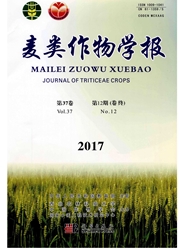

 中文摘要:
中文摘要:
为了解Lr1基因在小麦育种中的利用情况,通过PCR分子标记技术检测了小麦抗叶锈病基因Lr1在小麦骨干亲本南大2419、阿夫、燕大1817和碧蚂4号及其328个衍生品种中的分布情况。结果显示,Lr1基因在4个骨干亲本衍生品种中的频率为:燕大1817(80.0%)〉阿夫(78.1%)〉南大2419(54.3%)〉碧蚂4号(32.4%);Lr1基因在各个亲本衍生后代的最高频率分别是:阿夫子三代90.0%,燕大1817子三代100.0%,南大2419子五代100.0%,碧蚂4号子三代45.0%。Lr1基因的分布频率呈现出从冬小麦区到春小麦区上升的趋势。研究表明骨干亲本的选用更注重其综合性状而非是否含有Lr1基因,环境条件、亲本和杂交方式的选择及其相互作用影响了Lr1基因在骨干亲本衍生品种中的分布形势,其基因的表现型可能与选择牵连效应有关。
 英文摘要:
英文摘要:
In this study, the distribution frequencies of leaf rust resistance geneLrl in four founder wheat parents of Nanda 2419, Funo, Yanda 1817 and Bima 4, and 328 derivatives were determined using PCR-based molecular marker. The frequencies of Lr1 gene in these derivatives were as: Yanda 1817 (80.0%) 〉 Funo (78.1%) 〉 Nanda 2419 (54.3%)〉 Bima 4 (32.4%). It was observed that the highest frequency of Lrl in the derivatives of Funo, Yanda 1817, Nanda 2419 and Bima 4 appeared in the third generation (90.0 %), the third generation(100.0 %), the fifth generation(100.0%), and the third generation (45.0%), respectively. The frequencies of Lr1 genes showed an upward trend from winter wheat zones to spring wheat zones. The results demonstrated that the utilization of founder wheat parents did not base on the existence of Lr1 gene, but on their complex traits. So the distribution of Lr1 gene in Chinese wheat zones was affected by environmental elements, parents factor, and selection of crossing patterns. The phenotype of Lr1 gene in the derivative varieties might be associated with the hitchhiking effect.
 同期刊论文项目
同期刊论文项目
 同项目期刊论文
同项目期刊论文
 期刊信息
期刊信息
